-
An AWS account:
- If you have an existing account, log in: https://aws.amazon.com/ > Sign In to the Console.
- If you do not have an existing account, create one: https://aws.amazon.com/free > Create a Free Account.
- IAM permissions: In a later step, AWS CloudFormation creates required infrastructure in your account. To learn how to create the associated role, see Creating IAM Roles with AWS CloudFormation.
- SSH key pair: For secure access to the Amazon EC2 instance that CloudFormation creates in a later step, create an SSH key pair. To learn how, see Create a key pair for your Amazon EC2 instance.
Part I: Setting up the Virtual Private Cloud (VPC)
Note: If you have already configured a Virtual Private Cloud (VPC) for your organization that meets the requirements for deploying the Unstructured API, you may skip this part and proceed to the Part II. Ensure that your existing VPC setup includes the necessary subnets, internet gateway, and route tables as outlined in this guide. In Part I, you will construct a resilient and secure infrastructure within AWS by setting up a Virtual Private Cloud (VPC). Your VPC will encompass a dual-tiered subnet model consisting of both public and private subnets across multiple Availability Zones (AZs). You will establish the foundational network structure for deploying the Unstructured API by creating two public subnets and one private subnet within your VPC. The public subnets will host resources that require direct access to the internet, such as a load balancer, enabling them to communicate with external users. The private subnet is designed for resources that should not be directly accessible from the internet, like EC2 Compute Engine.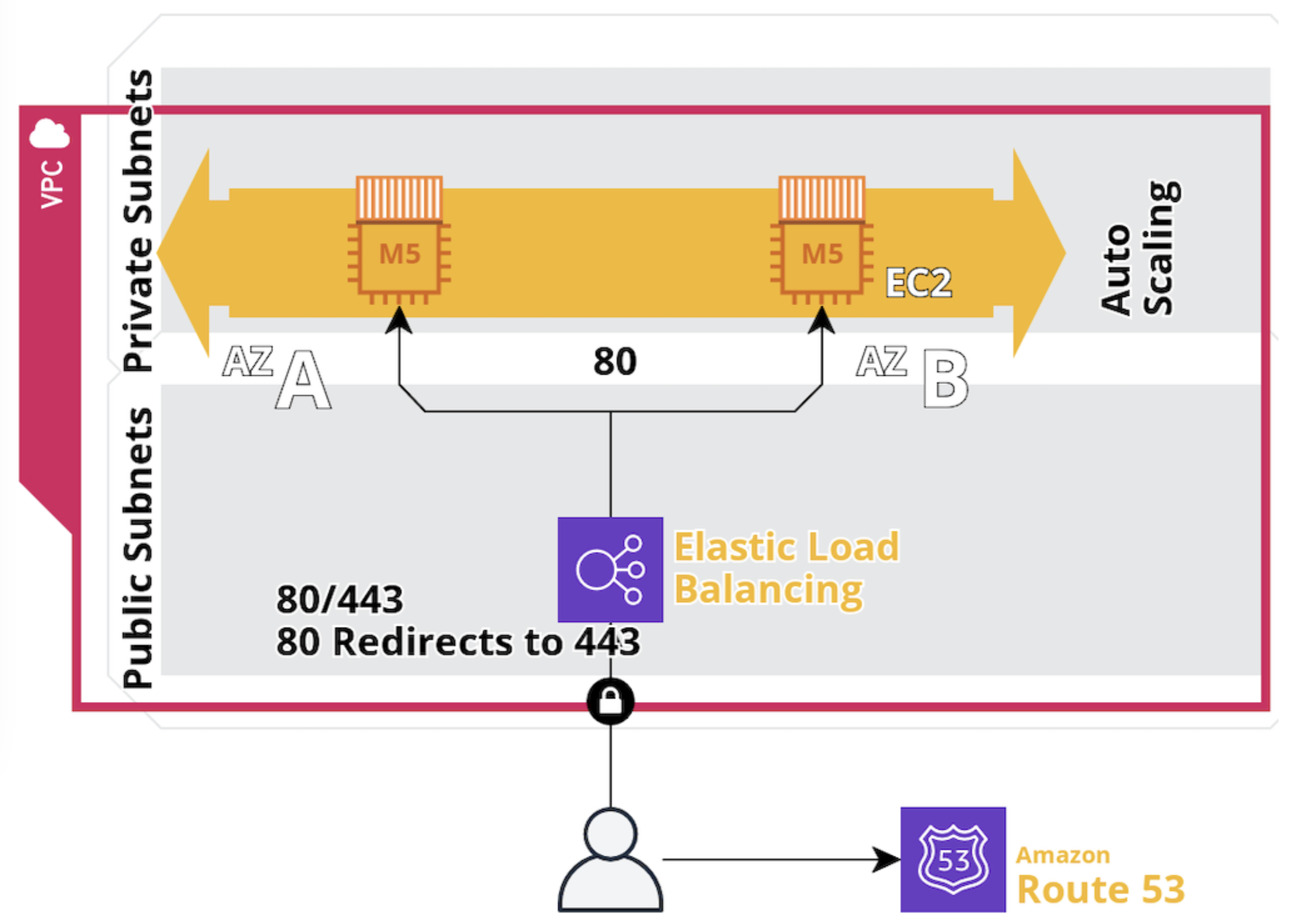
-
Access the VPC dashboard:
a. In the AWS Management Console, in the top menu bar, click Services > Networking & Content Delivery > VPC.
b. In the sidebar, click Your VPCs, and then click Create VPC.
-
Create the VPC:
a. Select VPC only.
b. Enter a Name tag for your VPC.
c. Specify the IPv4 CIDR block (for example,10.0.0.0/16).
d. You may leave IPv6 CIDR block, Tenancy, and Tags settings at their defaults.
e. Click Create VPC.
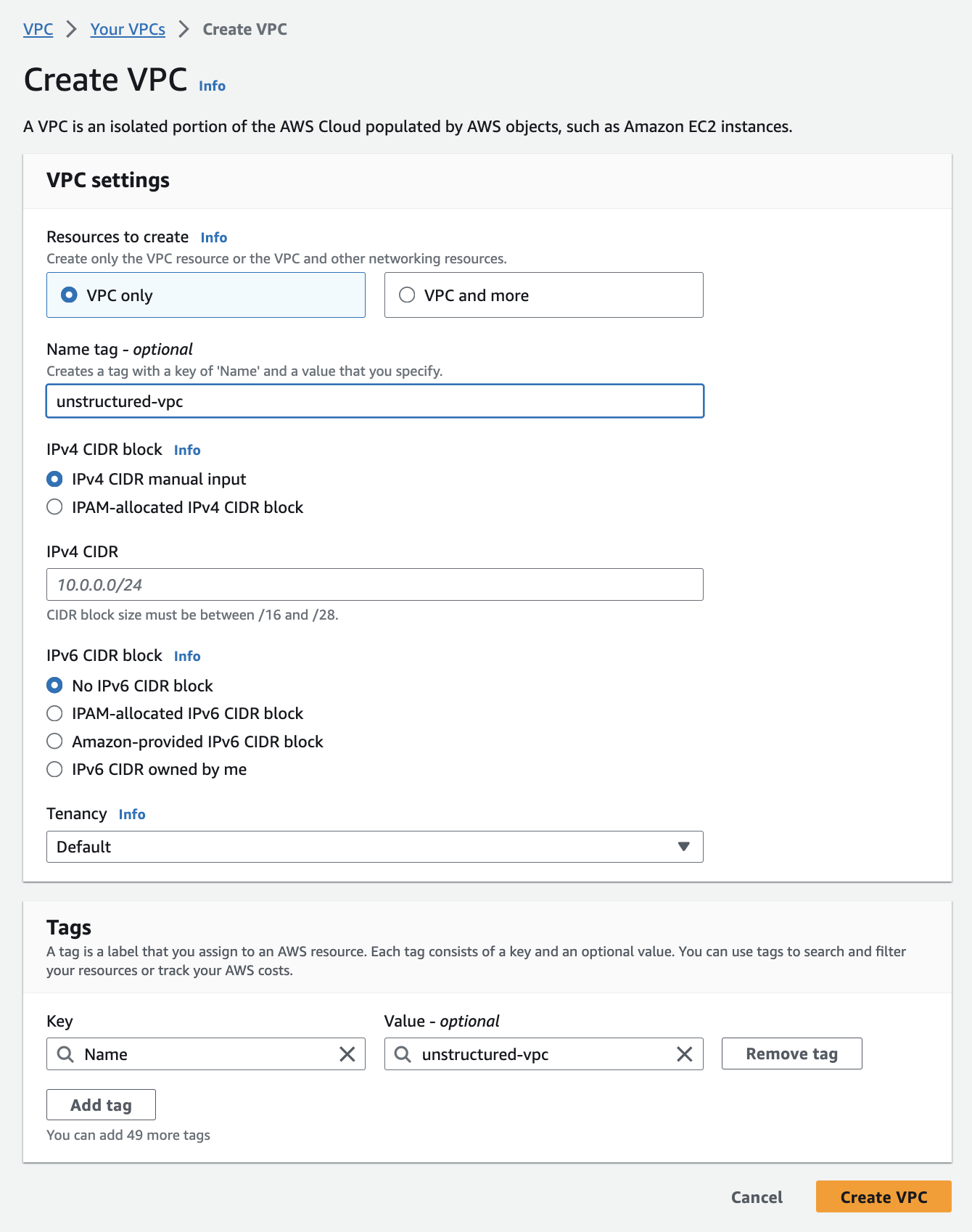
-
Create the subnets:
a. After creating the VPC, in the sidebar, click Subnets.
b. Click Create subnet.
c. In the VPC ID dropdown menu. select the VPC that you just created.
d. For the first public subnet:
- Enter a Subnet name.
- Select an Availability Zone.
-
Specify the IPv4 CIDR block (for example,
10.0.0.0/16). -
Specify the IPv4 subnet CIDR block (for example,
10.0.1.0/24). - You may leave the Tags setting at its default.
- Click Add new subnet. (Do not click Create subnet yet.)
10.0.2.0/24).
- Note: Each subnet must reside entirely within one Availability Zone and cannot span zones. If you specify the same Availability Zone or IPv4 subnet CIDR block as the first public subnet, AWS CloudFormation might fail in a later step.
- To learn more, see Subnet basics.
- Click Add new subnet. (Do not click Create subnet yet.)
10.0.3.0/24).
- Note: Each subnet must reside entirely within one Availability Zone and cannot span zones. If you specify the same Availability Zone or IPv4 subnet CIDR block as the first or second public subnets, AWS CloudFormation might fail in a later step.
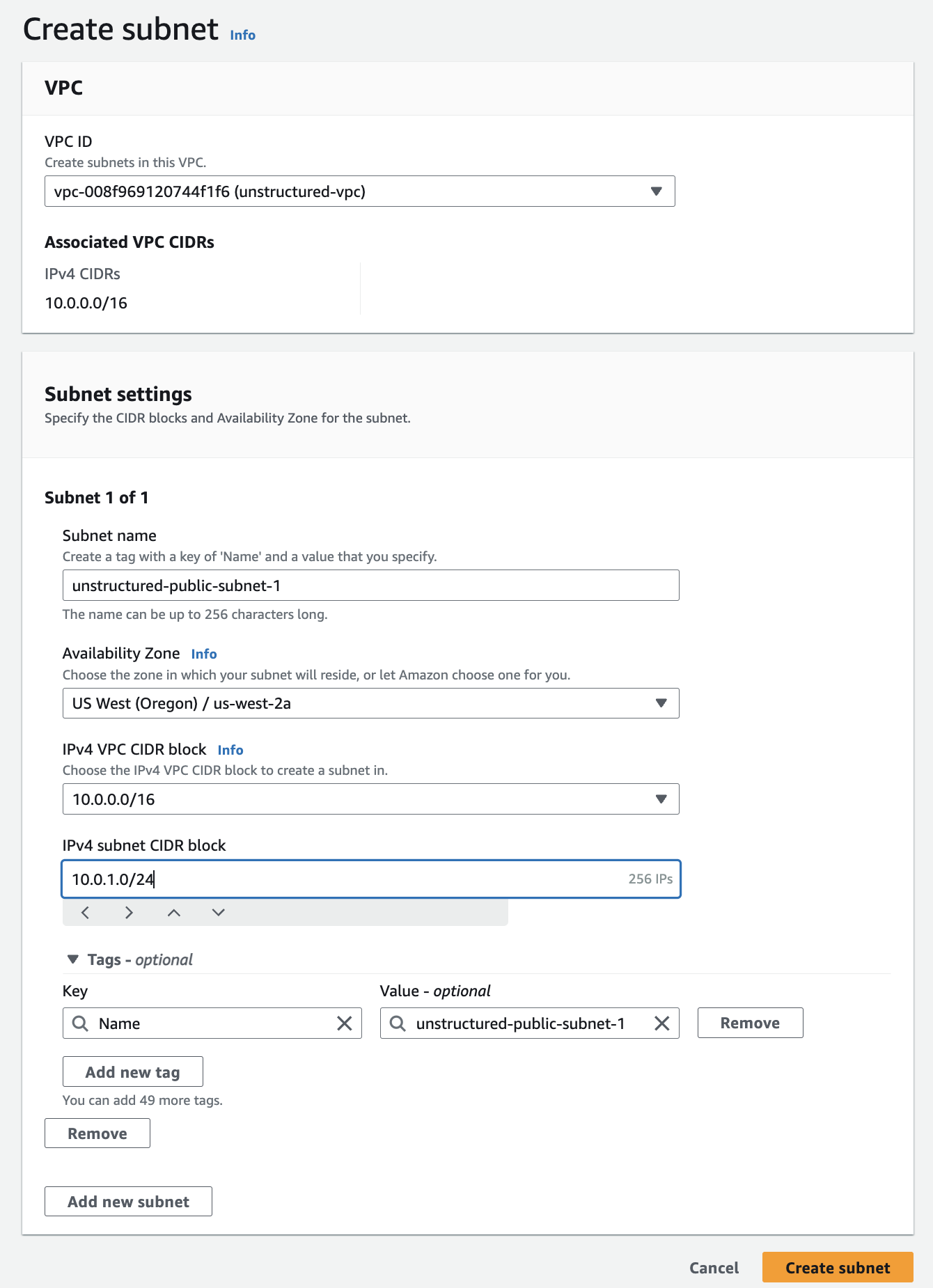
-
Create the internet gateway (for the public subnets):
a. In the sidebar, click Internet gateways.
b. Click Create internet gateway, enter a Name tag, and click Create internet gateway.
c. In the sidebar, click Internet gateways again.
d. Click the Internet gateway ID for the internet gateway that you just created.
e. Click Actions > Attach to VPC.
f. In the Available VPCs dropdown list, select the VPC from Step 2 - Create the VPC.
g. Click Attach internet gateway.
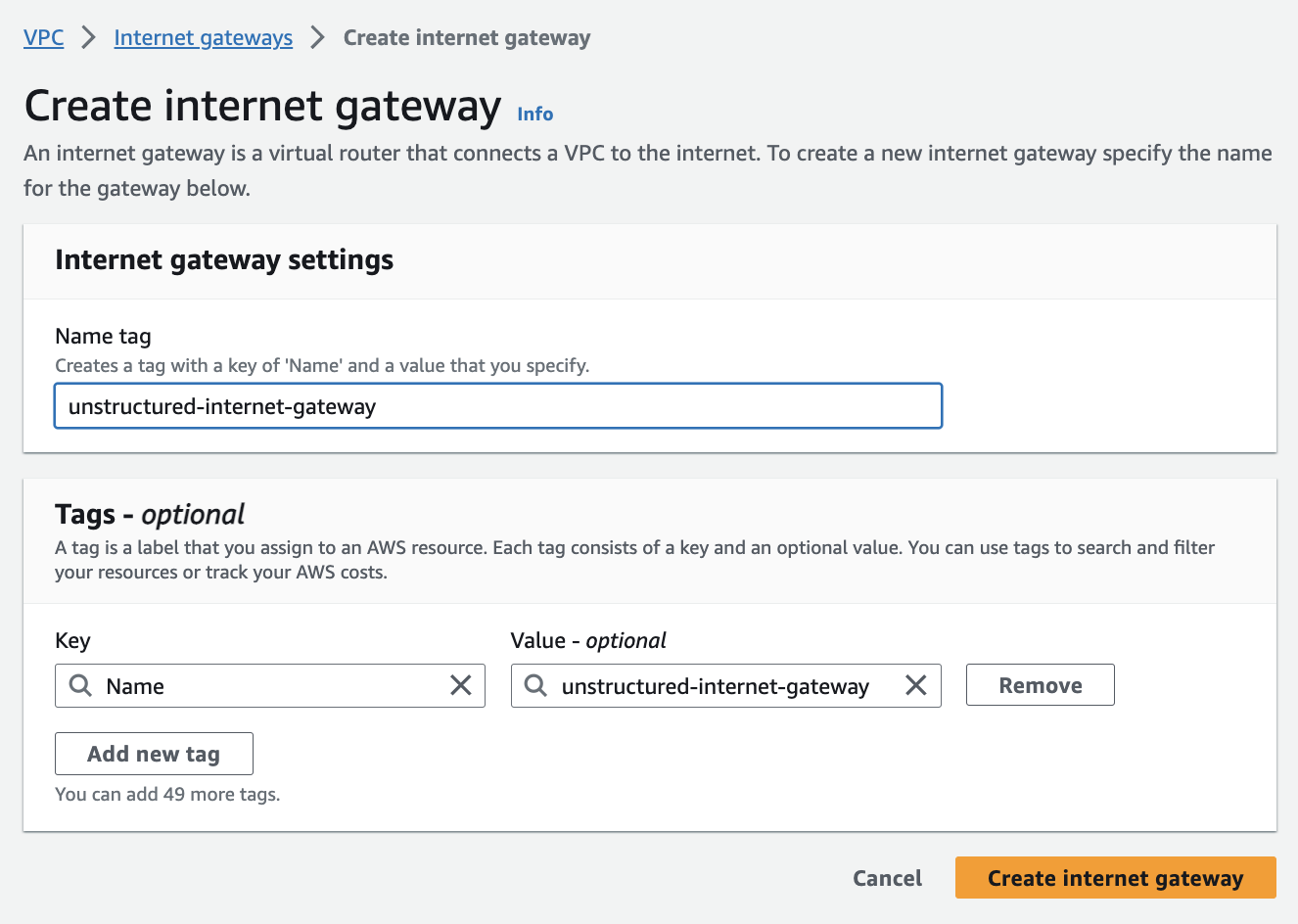
- Set up route tables (for the public subnets): AWS automatically created a default route table in Step 3 - Create the subnets. To tailor your network architecture, you will create a new route table specifically for your public subnets, which will include a route to the internet gateway from Step 4 - Create the internet gateway (for the public subnets). a. In the sidebar, click Route tables. b. Click Create route table. c. Enter a Name. d. Select the VPC from Step 2 - Create the VPC. e. Click Create route table.
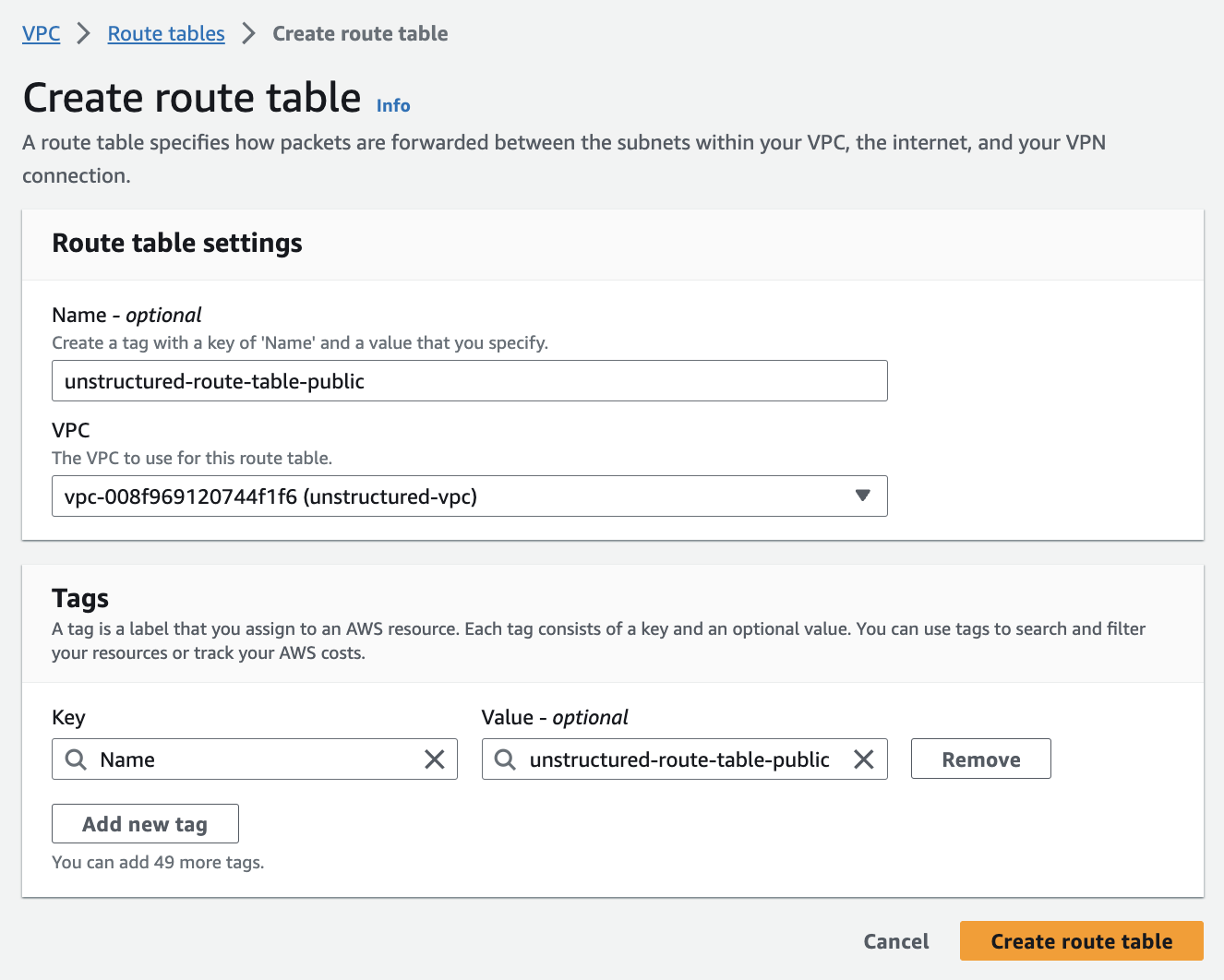
-
Associate public subnets to the route table and internet gateway:
a. Connect the public subnets to the route table from Step 5 - Set up route tables (for the public subnets):
- In the sidebar, click Subnets.
- Select the first public subnet from Step 3 - Create the subnets.
- Click Actions > Edit route table association.
- In the Route table ID dropdown list, select the route table from Step 5 - Set up route tables (for the public subnets), and then click Save.
- Repeat the process for the second public subnet.
- In the sidebar, click Route tables.
- Select the route table from Step 5 - Set up route tables (for the public subnets).
- Click Actions > Edit routes.
-
Click Add route, in the destination box, enter
0.0.0.0/0, which represents all IP addresses. In the Target dropdown list, select Internet Gateway, and select the internet gateway from Step 4 - Create the internet gateway (for the public subnets). - Click Save changes to establish the route, granting internet access to the first and second public subnets at the same time.
- In the sidebar, click Subnets.
- Select the private subnet from Step 3 - Create the subnets.
- Click Actions > Edit route table association.
- In the Route table ID dropdown list, select the main route table, or create and then select a new route table without a route to the internet gateway.
- Click Save.
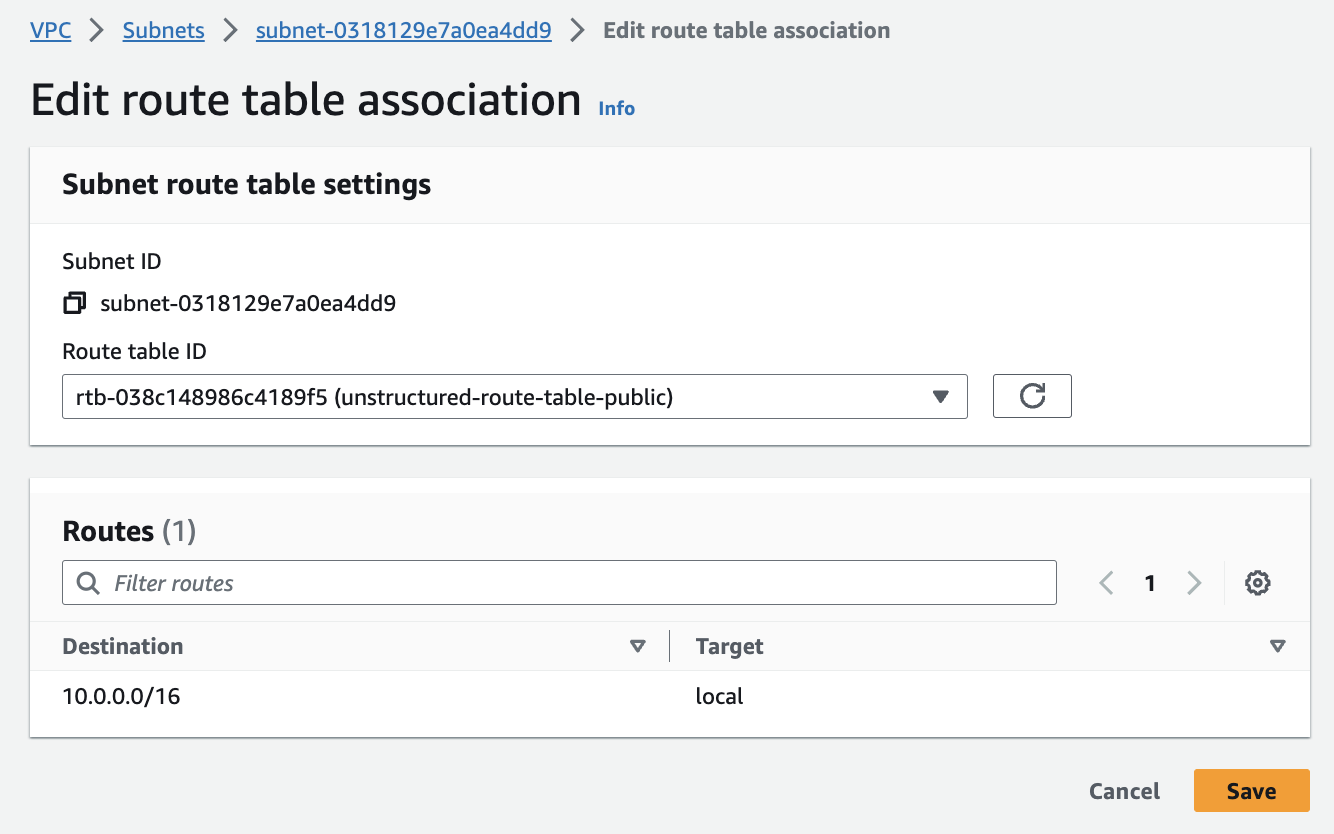

- Inspect the VPC resource map: You can check the configurations from the resource maps on the VPC details dashboard by clicking Your VPCs in the sidebar, clicking the VPC ID for your VPC, and then clicking the Resource map tab.
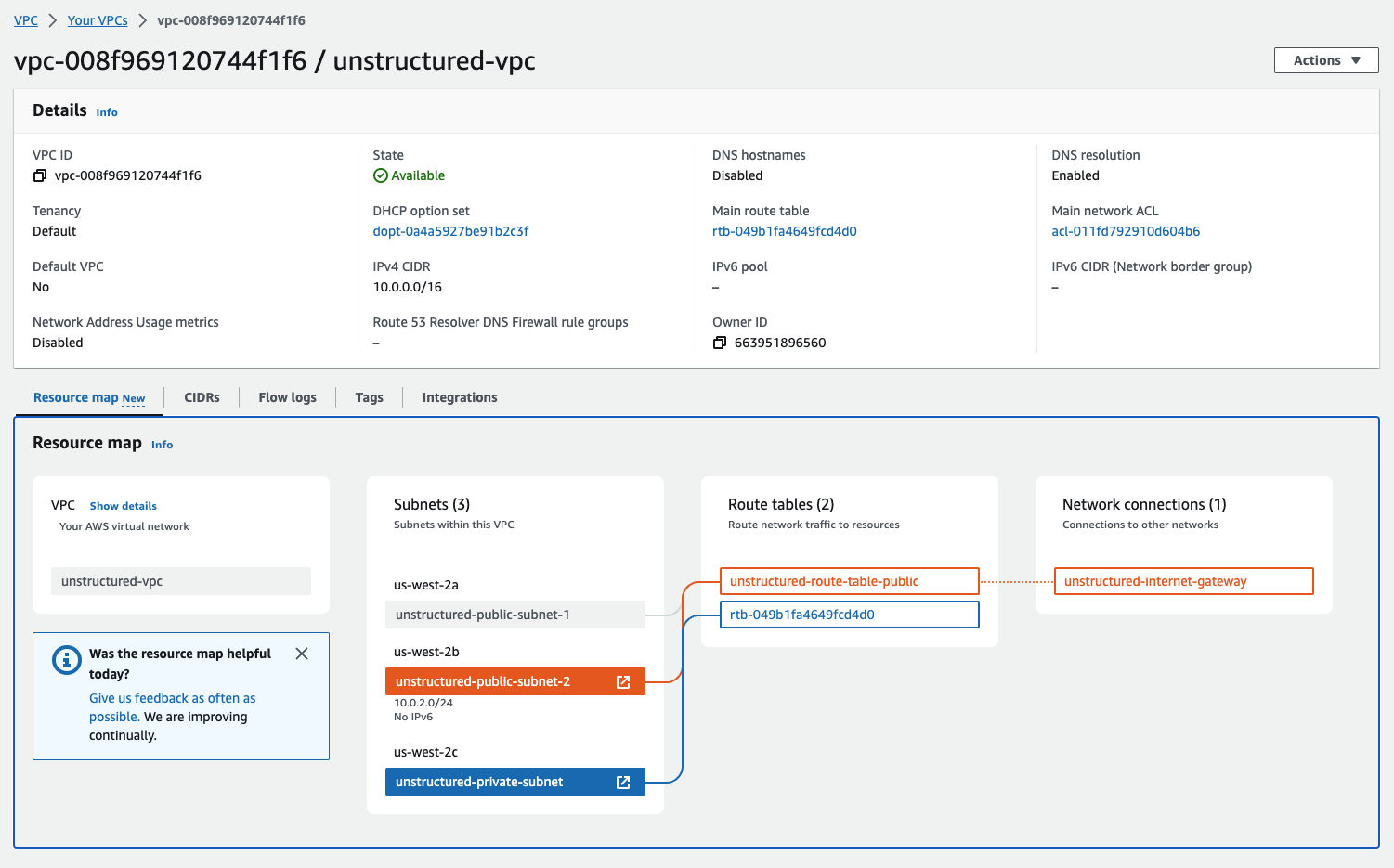
Part II: Deploying the Unstructured API from the AWS Marketplace
- Go to the Unstructured API page on AWS Marketplace: a. Leaving the VPC dashboard from Part I open, in a separate web browser tab, go to the Unstructured API product page in the AWS Marketplace. b. Click Continue to Subscribe. c. Review the terms and conditions. d. Click Continue to Configuration.
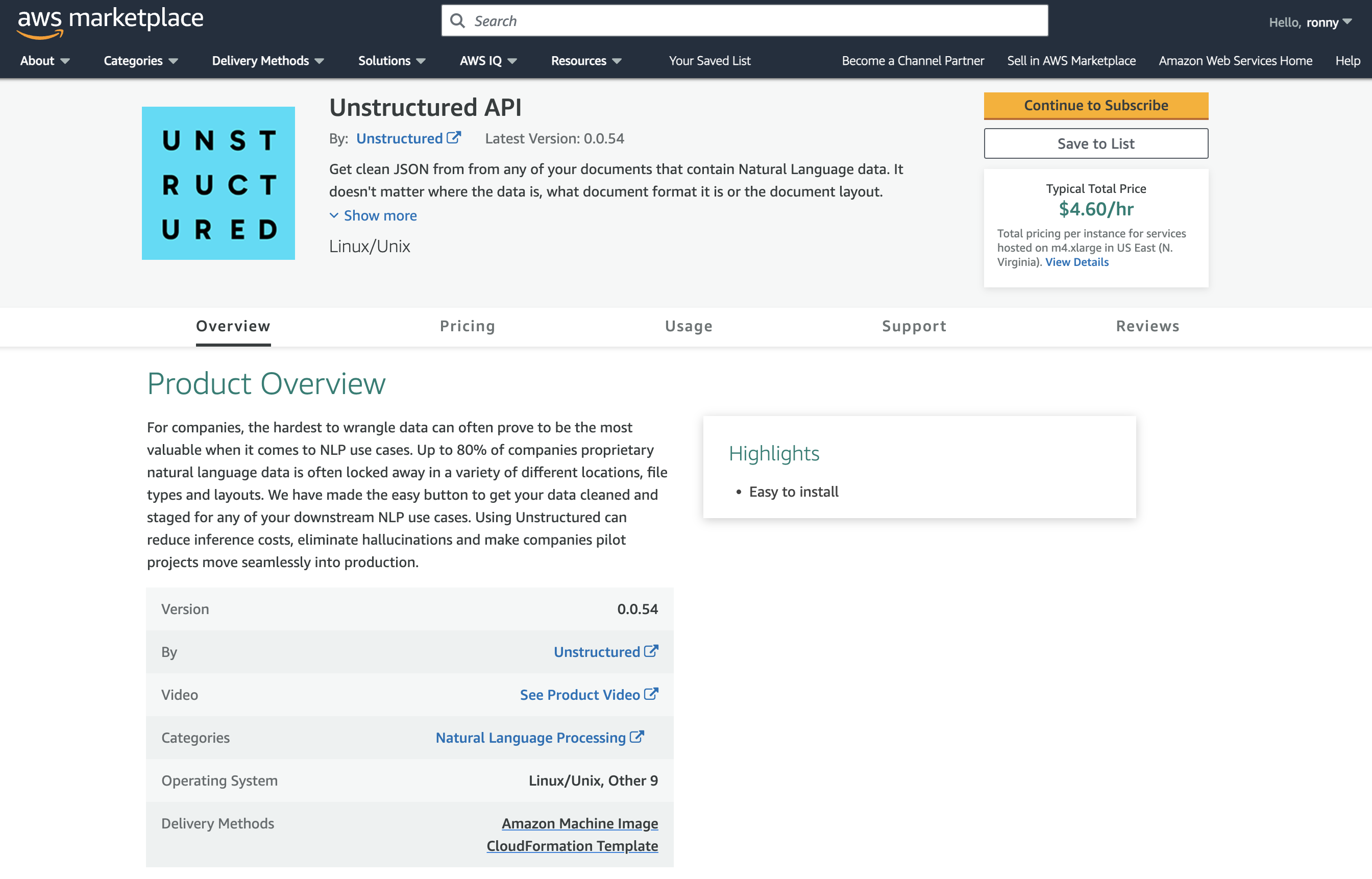
-
Configure the CloudFormation template:
a. In the Fulfillment option dropdown list, select CloudFormation Template.
b. For Fulfillment option and Software version, leave the default
UnstructuredAPItemplate and software version. c. In the Region dropdown list, select the Region that corresponds to the VPC from Part I.- Note: You must select the same Region where you set up the VPC in Part I. To find the Region, on the VPC dashboard tab from Part I that you left open, with your VPC displayed, find the VPC’s Region name next to your username in the top navigation bar.
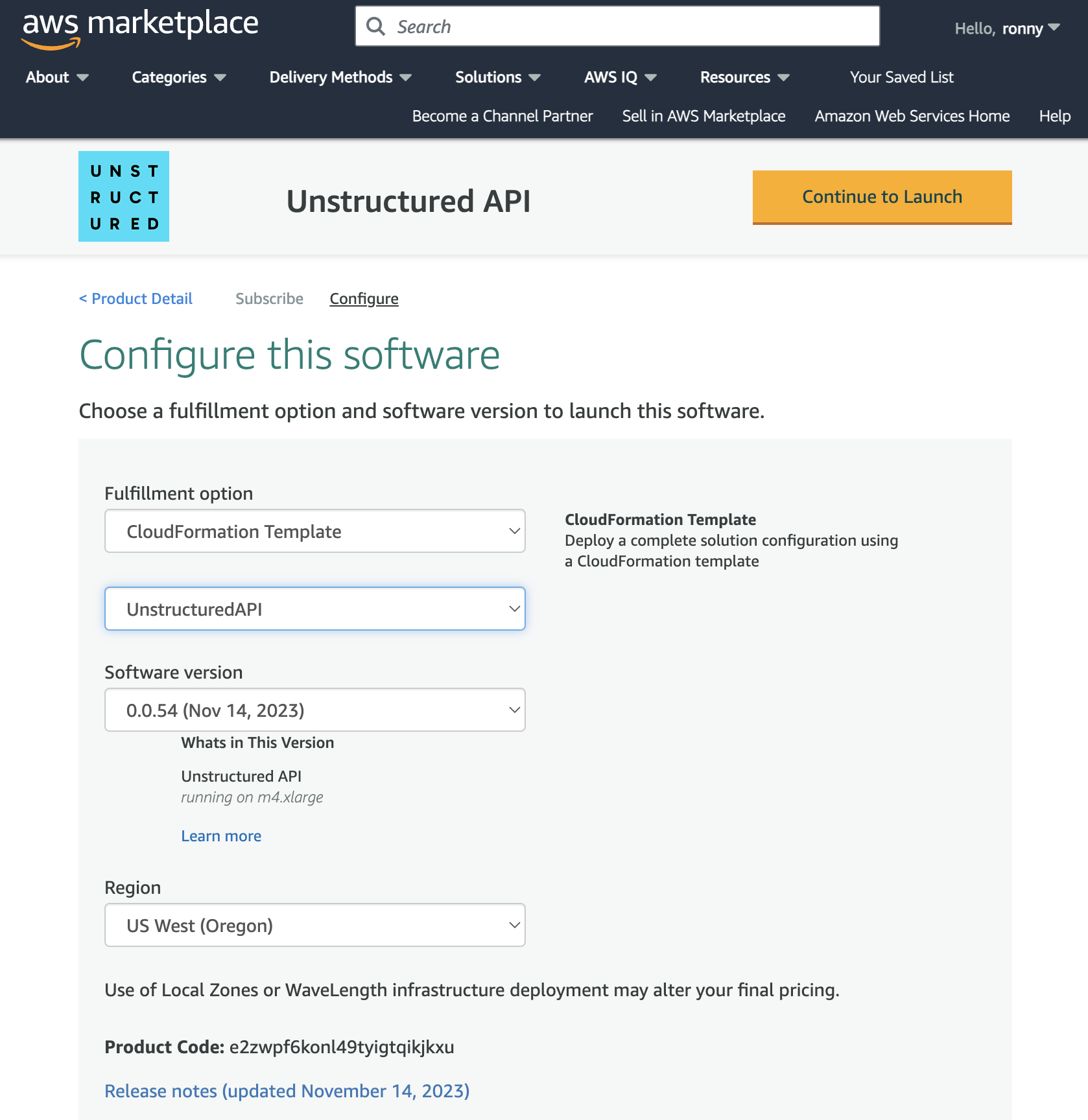
- Create the CloudFormation stack:
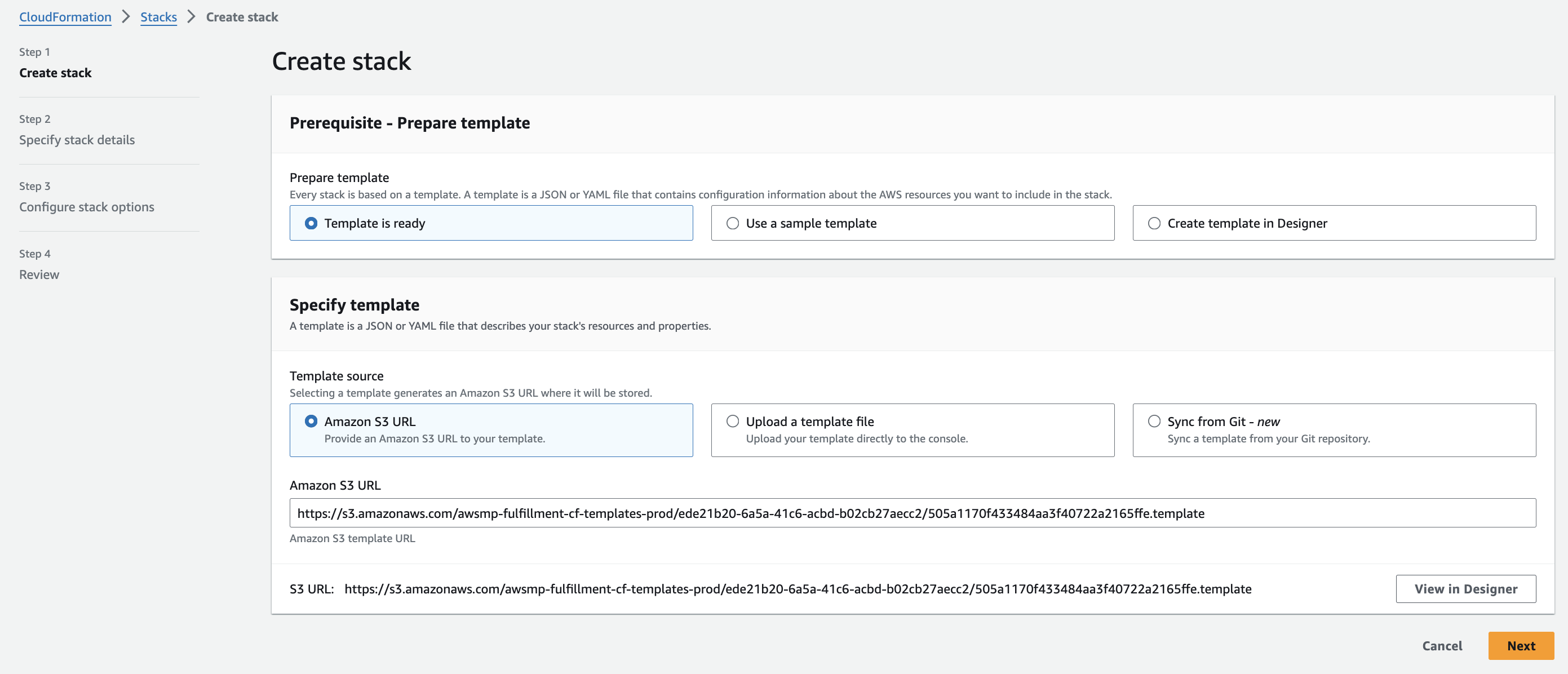
0.0.0.0/0, but only if you allow public access on the internet.
-
Note: It is generally recommended to limit SSH access to a specific IP range for enhanced security. This can be done by setting the
SSHLocationto the IP address or range associated with your organization. Please consult your IT department or VPN vendor to obtain the correct IP information for these settings. -
AWS provides
AWS Client VPN, which is a managed client-based VPN service that enables secure access AWS resources and resources in your on-premises network. To learn more, see Getting started with AWS Client VPN.
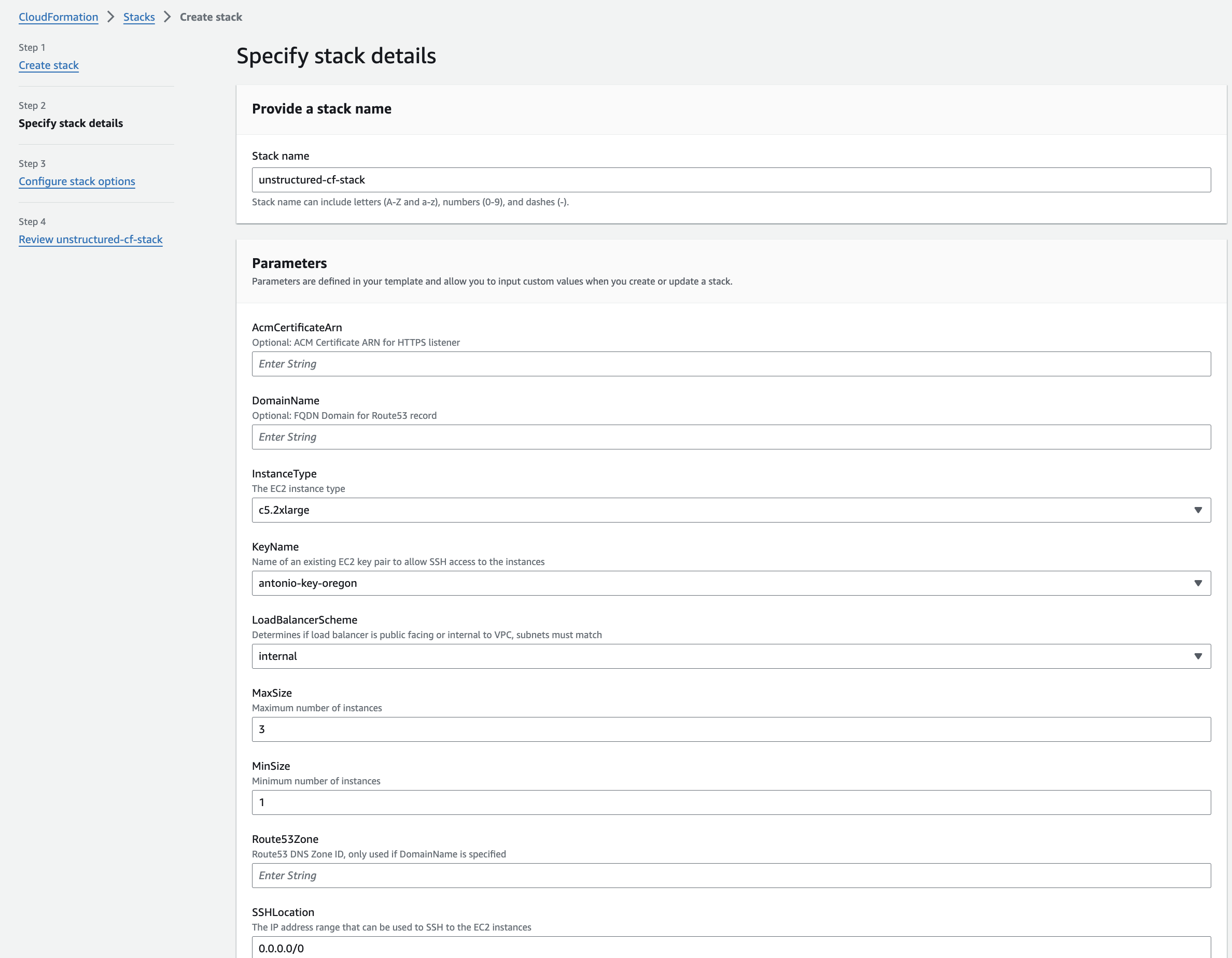
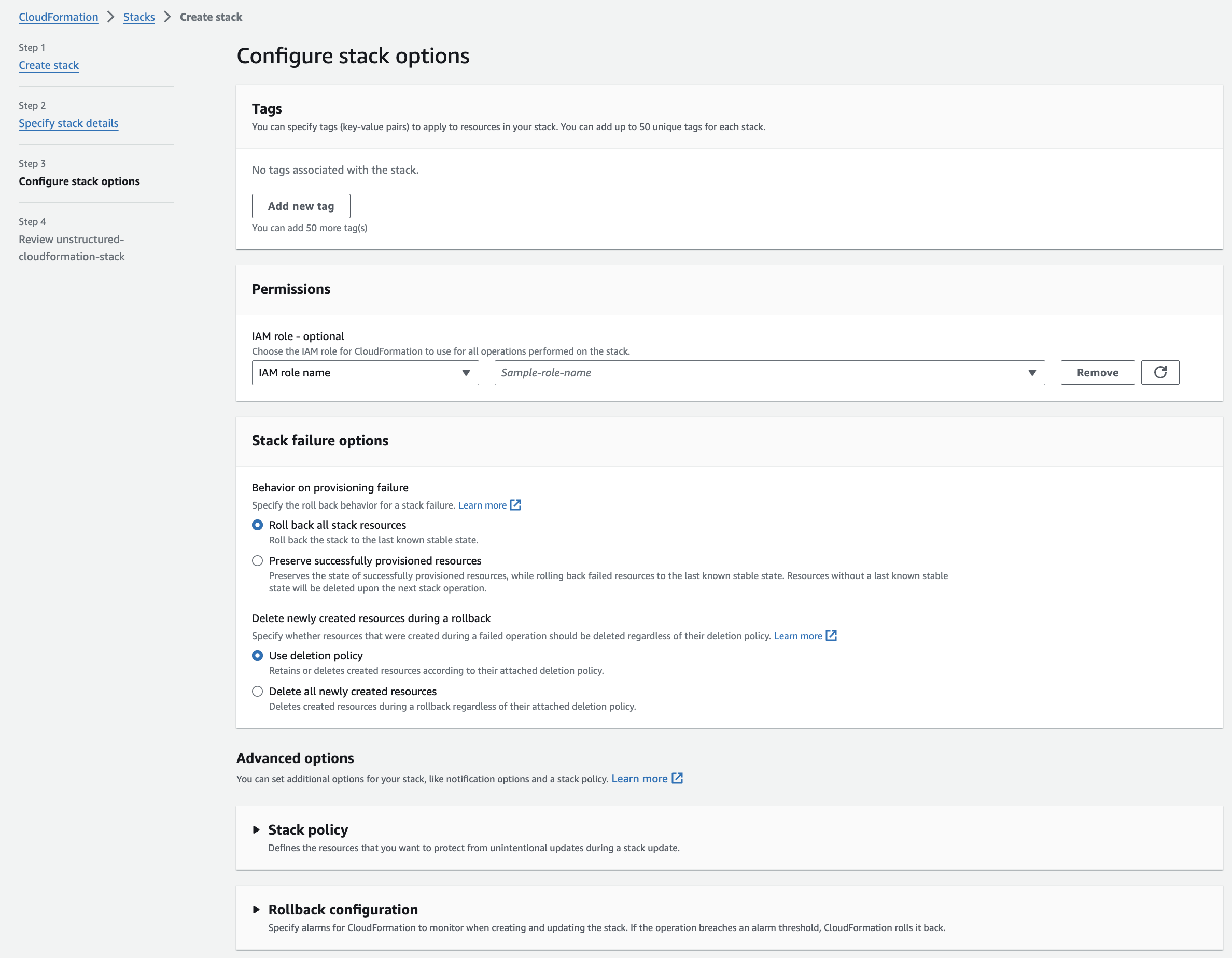
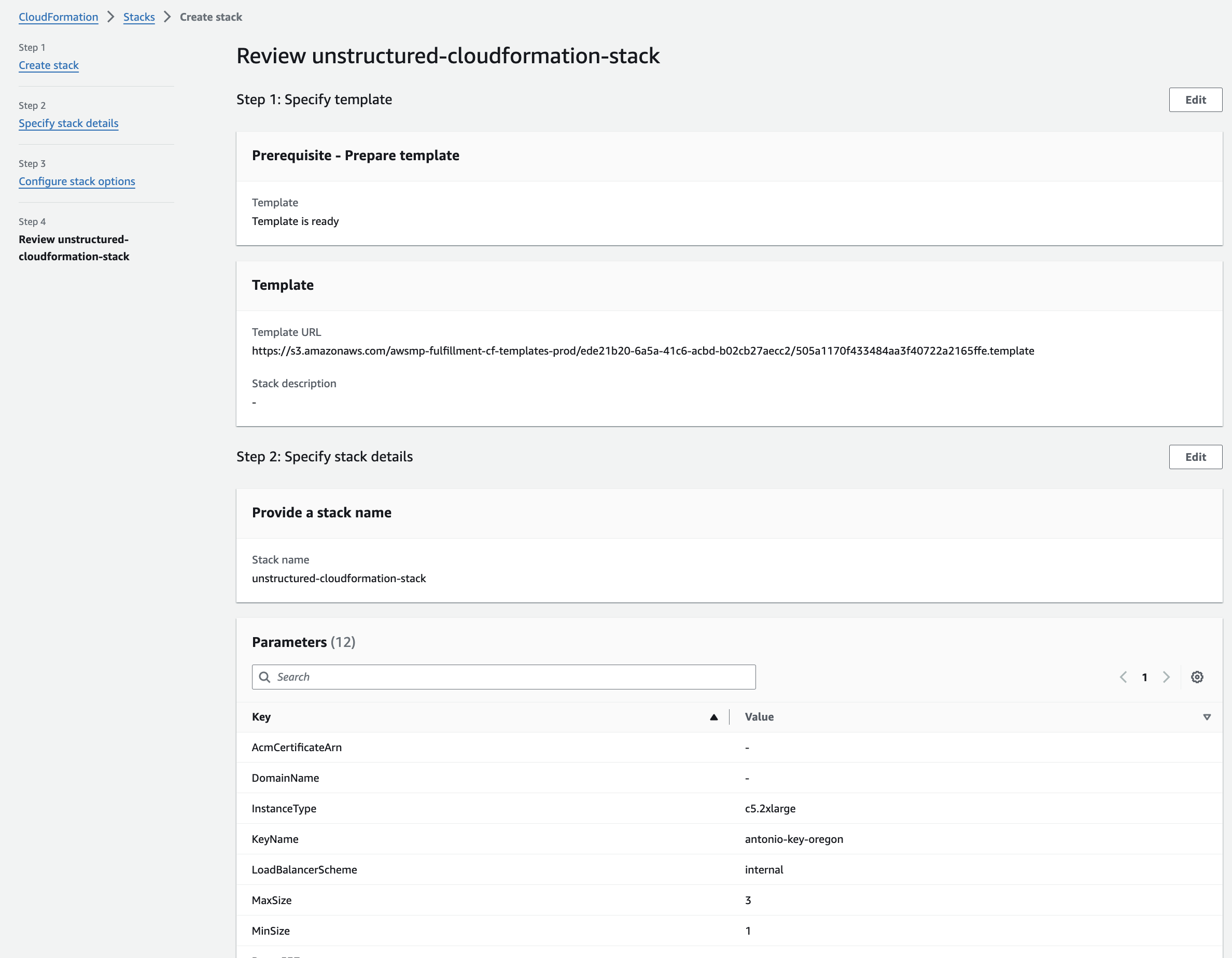
- Get the Unstructured API endpoint:
.elb.amazonaws.com.
- Note: You will use this DNS Name to replace the
<application-load-balancer-dns-name>for the following healthcheck and data processing steps.
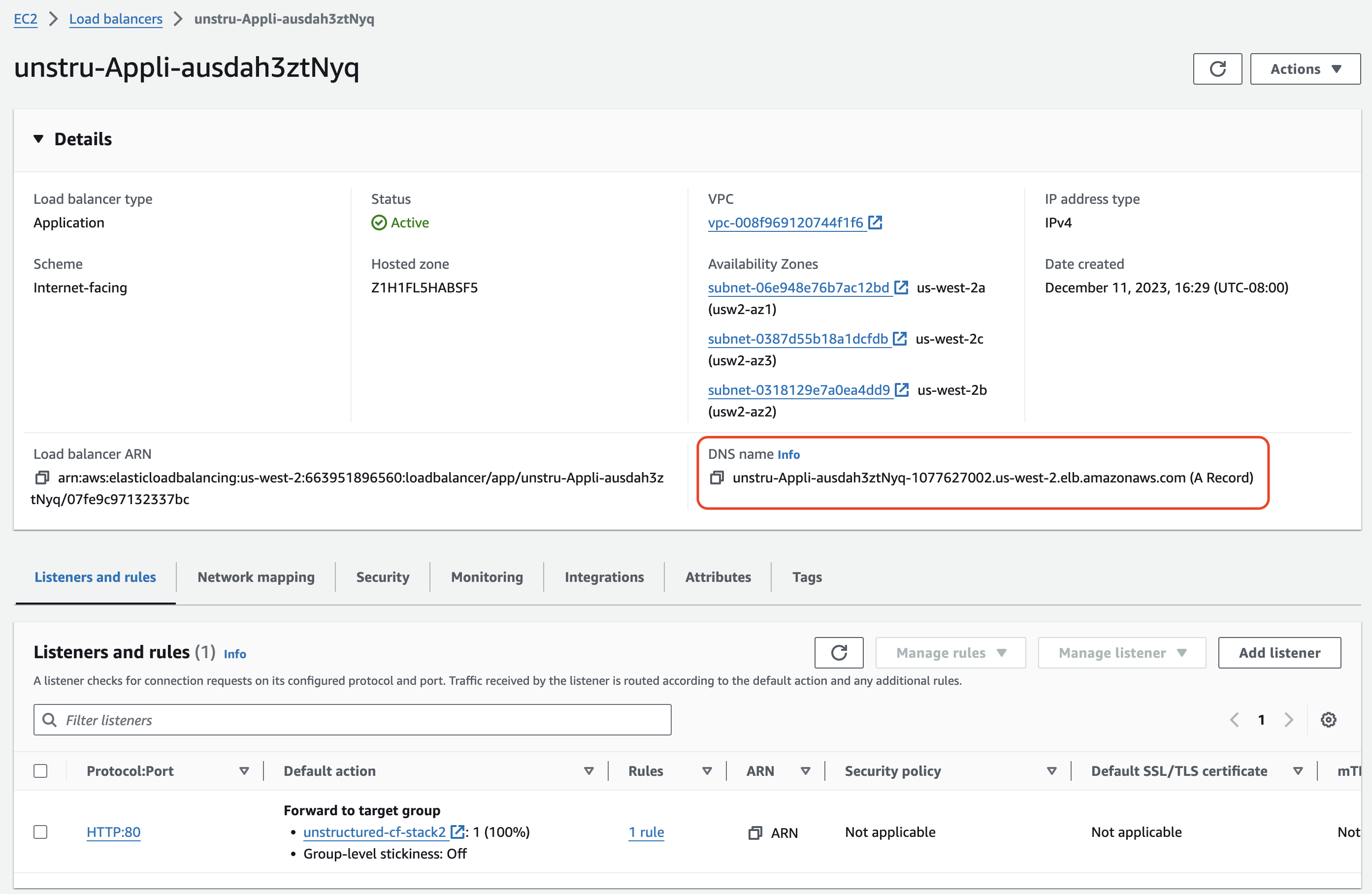
Healthcheck
Perform a health check by running this curl command from a terminal on your local machine, replacing<application-load-balancer-dns-name> with your application load balancer’s DNS name. This health check can take several minutes:

Data processing
For example, run one of the following, setting the following environment variables to make your code more portable:-
Set
UNSTRUCTURED_API_URLtohttp://, followed by your load balancer’s DNS name, followed by/general/v0/general.You can now use this value (http://, followed by your load balancer’s DNS name, followed by/general/v0/general) in place of calling the Unstructured Partition Endpoint URL as described elsewhere in the Unstructured API documentation. -
Set
LOCAL_FILE_INPUT_DIRto the path on your local machine to the files for the Unstructured API to process. If you do not have any input files available, you can download any of the ones from the example-docs folder in GitHub. -
Set
LOCAL_FILE_OUTPUT_DIRto the path on your local machine for Unstructured API to send the processed output in JSON format:
Ingest CLI
Ingest CLI
You must first install the Unstructured Ingest CLI.Because you are calling a private API and therefore do not need an Unstructured API key, you can omit the command-line option
--api-key Or, for better code portability, it is recommended that you first set the environment variable UNSTRUCTURED_API_KEY to an empty string and then include the command-line option --api-key.CLI
Ingest Python library
Ingest Python library
You must first install the Unstructured Ingest Python library.Because you are calling a private API and therefore do not need an Unstructured API key, you can omit the parameter
api_key. Or, for better code portability, it is recommended that you first set the environment variable UNSTRUCTURED_API_KEY to an empty string and then include the parameter api_key.Python Ingest
Accessing the hosting EC2 instance
If you need to access the Amazon EC2 instance that hosts the Unstructured API, do the following:- In the CloudFormation console, open the details page for the stack from Part II. If you do not see it, on the CloudFormation console’s sidebar, click Stacks, and then click the name of your stack.
- Click the Resources tab on this stack’s details page. Then click the Physical ID link next to EC2TargetGroup on this tab.
- On the EC2 > Target groups > (CloudFormation stack name) page that appears, on the Targets tab, click the Instance ID link.
- In the list of instances that appears, click the Instance ID link.
- Click Connect, and then follow any of the on-screen options to access the EC2 instance.
Manage related AWS account costs
After you run the CloudFormation stack that you created in Part II, charges will begin accruing to your AWS account on an ongoing basis for related AWS resources. The amounts of these charges vary based on where these resource are located, which resources are covered by AWS Free Tier offerings, the extent to which you customize these resources’ settings, how much you use these resources, and other factors. Stopping or terminating the related Amazon EC2 instances alone will not eliminate these ongoing charges. To stop these charges from accruing, delete the CloudFormation stack that you created and ran in Part II. This stops and deletes all of the related AWS resources. Before you delete the stack, note the following:- You should click the Resources tab on the stack’s details page to be aware of the associated resources that will be deleted.
-
You should note any resource dependencies, resources with deletion protection or termination protection enabled, or nested stacks
that might prevent stack deletion, and resolve these issues that could prevent stack deletion. To find these kinds of issues:
- On the Template tab on the stack’s details page, look for occurences of the
DependsOnattribute, which are set to the name of the resource dependency. - On the Template tab on the stack’s details page, look for occurences of the
DeletionPolicyattribute set toRetainor theUpdateReplacePolicyattribute set toRetain. The associated resources have deletion protection enabled. - On the Stack info tab on the stack’s details page, look for the Termination protection field. If it is set to Activated, termination protection is enabled.
- On the Resources tab on the stack’s details page, look for resources with their Type set to
AWS::CloudFormation::Stack. These indicate nested stacks.
- On the Template tab on the stack’s details page, look for occurences of the

